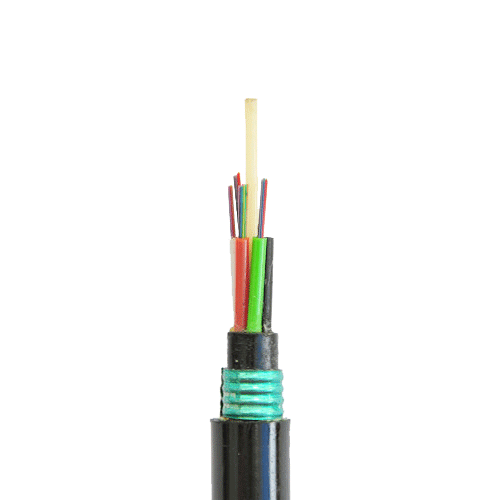Definition of Fiber Optics
1、Fiber optic
Fiber optic, abbreviated as optical fiber, is a type of fiber made of glass or plastic that can be used as a tool for light transmission. The transmission principle is "total reflection of light".
 2、Types of optical fibers
2、Types of optical fibers
There are many types of optical fibers, and the required functions and performance vary depending on the purpose. But for fiber optic cables used in cable television and communication, the design and manufacturing principles are basically the same, such as:
① low loss;
② Has a certain bandwidth and low dispersion;
③ Easy wiring;
④ Easy to unify;
⑤ High reliability;
⑥ Manufacturing is relatively simple;
⑦ Affordable, etc.
The classification of optical fibers is mainly summarized from the working wavelength, refractive index distribution, transmission mode, raw materials, and manufacturing methods. Here are various examples of classifications.
(1) Working wavelengths: UV fiber, observable fiber, near-infrared fiber, infrared fiber (0.85pm, 1.3pm, 1.55pm)
(2) Refractive index distribution: step (SI) type, near step type, gradient (GI) type, other (such as triangular, W-type, concave type, etc.).
(3) Transmission mode: single-mode fiber (including polarization maintaining fiber and non polarization maintaining fiber), multi-mode fiber.
(4) Raw materials: quartz glass, multi-component glass, plastic, composite materials (such as plastic cladding, liquid fiber core, etc.), infrared materials, etc. According to the coating material, it can also be divided into inorganic materials (carbon, etc.), metal materials (copper, nickel, etc.), and plastics.
(5) Manufacturing methods: Pre molding includes vapor phase axial deposition (VAD), chemical vapor deposition (CVD), etc. Drawing methods include Rod intube and double crucible methods.

Quartz optical fiber is a type of optical fiber that uses silicon dioxide (SiO2) as the main raw material and controls the refractive index distribution of the core and cladding according to different doping amounts. The quartz (glass) series optical fibers have the characteristics of low power consumption and broadband, and are now widely used in cable TV and communication systems. Compared with other optical fibers, silica fiber also has a broad spectrum of light transmission from ultraviolet to near-infrared light. In addition to communication purposes, it can also be used for light and its characteristics.
3. Light is an electromagnetic wave
The wavelength range of visible light is 390-760nm (millimicrons). The part larger than 760nm is infrared light, and the part smaller than 390nm is ultraviolet light. The main applications in optical fibers are 850nm,1310nm,1550nm.
4、The refraction, reflection, and total reflection of light
Due to the different propagation speeds of light in different substances, when light is directed from one substance to another, refraction and reflection occur at the interface between the two substances. Moreover, the angle of refracted light varies with the angle of incident light. When the angle of incident light reaches or exceeds a certain angle, the refracted light disappears and all incident light is reflected back, which is called total reflection of light. Different substances have different refractive angles for light of the same wavelength (i.e. different substances have different refractive indices), and the same substance also has different refractive angles for light of different wavelengths. Fiber optic communication is formed based on the above principles.

5、Fiber optic structure
Fiber optic bare fibers are generally divided into three layers: a central high refractive index glass core (core diameter generally 50 or 62.5μm) , with a low refractive index silicon glass cladding in the middle (usually with a diameter of 125μm) The outermost is the resin coating used for reinforcement.
6、Numerical aperture
The light incident on the fiber end face cannot be transmitted entirely by the fiber, only the incident light within a certain angle range can be transmitted. This angle is called the numerical aperture of the optical fiber. A larger numerical aperture of optical fibers is beneficial for fiber docking. The numerical aperture of optical fibers produced by different manufacturers varies.
7、Single mode fiber and multimode fiber:
(1)According to the transmission mode of light in optical fibers, it can be divided into single-mode fibers and multi-mode fibers.
Multimode fiber: The center glass core is thicker (50 or 62.5μm). It can transmit multiple modes of light. But its intermodal dispersion is relatively large, which limits the frequency of transmitting digital signals and becomes more severe with increasing distance.
Single mode optical fiber: The center glass core is relatively thin (core diameter is generally 9μm). Only one mode of light can be transmitted. Therefore, its intermodal dispersion is small and suitable for remote communication, but its chromatic dispersion plays a major role. Therefore, single-mode fibers have high requirements for the spectral width and stability of the light source, that is, the spectral width should be narrow and the stability should be good.
(2)Divided by the optimal transmission frequency window: conventional single-mode fiber and dispersion shifted single-mode fiber.
Conventional type: Fiber optic manufacturers optimize the transmission frequency of optical fibers on a single wavelength of light, such as 1300nm.
Dispersion displacement type: Fiber optic manufacturers optimizes the transmission frequency of optical fibers on two wavelengths of light, such as 1300nm and 1550nm.
(3) According to the distribution of refractive index, it can be divided into mutation type and gradient type optical fibers.
Mutant type: The refractive index from the center core of the optical fiber to the glass cladding is abrupt. It has low cost and high inter mode dispersion. Suitable for short distance low-speed communication, such as industrial control. However, due to the small intermodal dispersion, single-mode fibers all adopt a mutation type.
Gradient type fiber: The refractive index from the center core of the fiber to the glass cladding gradually decreases, allowing high mode light to propagate in a sinusoidal manner, reducing inter mode dispersion, increasing fiber bandwidth, and increasing transmission distance. However, the cost is relatively high. Nowadays, multimode fibers are mostly gradient type fibers.

8、Common fiber optic specifications
Single mode:9/125μm
Multimode:50/125μm, 62.5/125μm
Industrial, medical, and low-speed networks:100/140μm,200/230μm
Plastics:98/1000μm,Used in fields such as automotive control light guide and image transmission.
















